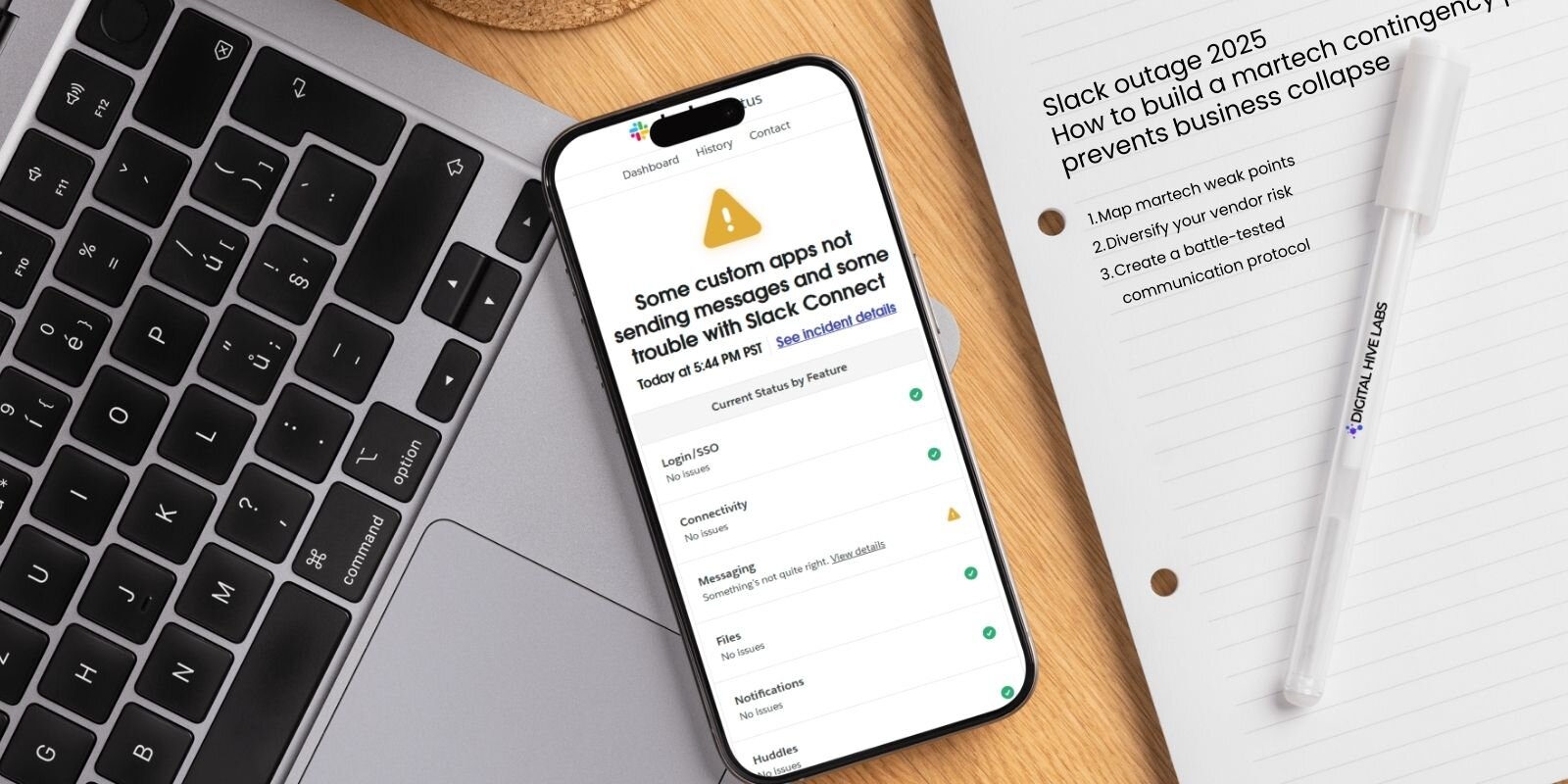Slack outage 2025: How to build a martech contingency plan that ensures resiliency for your business processes

When a critical piece of your martech stack crashes, it’s not just an inconvenience—it’s a full-blown business emergency. Just ask the millions of companies left scrambling during Slack’s massive outage on Wednesday, February 26, 2025. Messages froze, workflows collapsed, and teams worldwide faced hours of dead air. This isn’t hypothetical; it’s a wake-up call. If your marketing engine grinds to a halt every time a SaaS platform hiccups, you’re playing Russian roulette with your revenue. Let’s break down exactly how to bulletproof your operations against martech meltdowns.
The domino effect
On February 26, 2025, Slack users hit a wall at 10:30 AM ET. Channels stopped loading, messages vanished, and logins failed globally. DownDetector logged 3,000+ U.S. outage reports alone, with similar chaos in Europe and Canada. For businesses relying on Slack for daily ops, productivity flatlined.
Slack’s engineers restored core functions within hours, but residual issues lingered—a stark reminder that even $27B platforms (yes, Salesforce paid that much for Slack) aren’t immune to failure.
Building a martech contingency plan that actually works
A contingency plan for martech failures isn’t a luxury—it’s survival insurance. Here’s how to create one that kicks in automatically when systems crash.
Step 1: Map your martech weak points
Start by stress-testing your stack:
RiskImpactFallback SolutionCommunication tools downTeam collaboration haltsSwitch to email/Microsoft TeamsCRM outageLost lead tracking/sales pipeline gapsExport backups to spreadsheetsAnalytics platform crashBlind campaign optimizationUse native platform data (e.g., Meta Ads Manager) Pro tip: Run quarterly “disaster drills” where you simulate outages. Cantey Technology survived a literal office fire because they’d rehearsed switching to remote servers.
Step 2: Diversify your vendor risk
Putting all your eggs in one SaaS basket is begging for chaos.
The Slack outage encourages teams to:
- Never depend on a single vendor for mission-critical tasks
- Always have approved backups vetted and ready to deploy
Real-world example: During Slack’s downtime, companies that maintained Microsoft Teams licenses or Slack alternatives like Discord avoided total paralysis.
Step 3: Create a battle-tested communication protocol
When Slack went dark, the smartest teams didn’t panic—they pivoted.
Your outage playbook needs:
- Pre-written email/SMS templates alerting teams/clients to the issue
- A prioritized contact list (think: IT, executives, key clients)
- Clear escalation paths (e.g., “If X tool is down >15 mins, activate Y protocol”)
German telecom giant Deutsche Telekom once restored service to millions within 6 hours during a fire by using automated alerts and redundant systems. Copy their playbook.
3 Fallback strategies to steal from crisis-proof companies
1. The “hot swap” tactic
How it works: Maintain parallel access to competing tools.
- Example: Run Slack and Microsoft Teams simultaneously, synced via Zapier. If one fails, teams already know the alternative.
2. The data airbag
How it works: Auto-export critical data to neutral formats daily.
- Example: Cantey Technology avoided client downtime during a fire by backing up servers to a remote data center.
3. The human firewall
How it works: Train teams to recognize and manually replicate automated processes.
- Example: When automated ad bids fail, have media buyers ready to adjust campaigns manually using platform dashboards.
FAQs: Contingency planning for martech outages
Every quarter, or whenever you add/remove a martech tool. Markets shift faster than TikTok trends, your plan should too.
Assuming “it won’t happen to us.” Slack hadn’t had a major outage since 2023, until today. Complacency kills.
Yes. Start with free backups like Google Sheets for CRM data and encrypted USBs for creative assets. Proactivity > budget size.
Shield your business operations —act now to stay resilient
The Slack debacle exposed a harsh truth: every martech stack has a breaking point. But with the right contingency plan, you can turn disasters into mere speed bumps.
At Digital Hive Labs, we’ve helped businesses fortify their marketing ops against SaaS outages. Your first step? Let us audit your stack for single points of failure—for free. Because when your tech fails, your revenue shouldn’t.